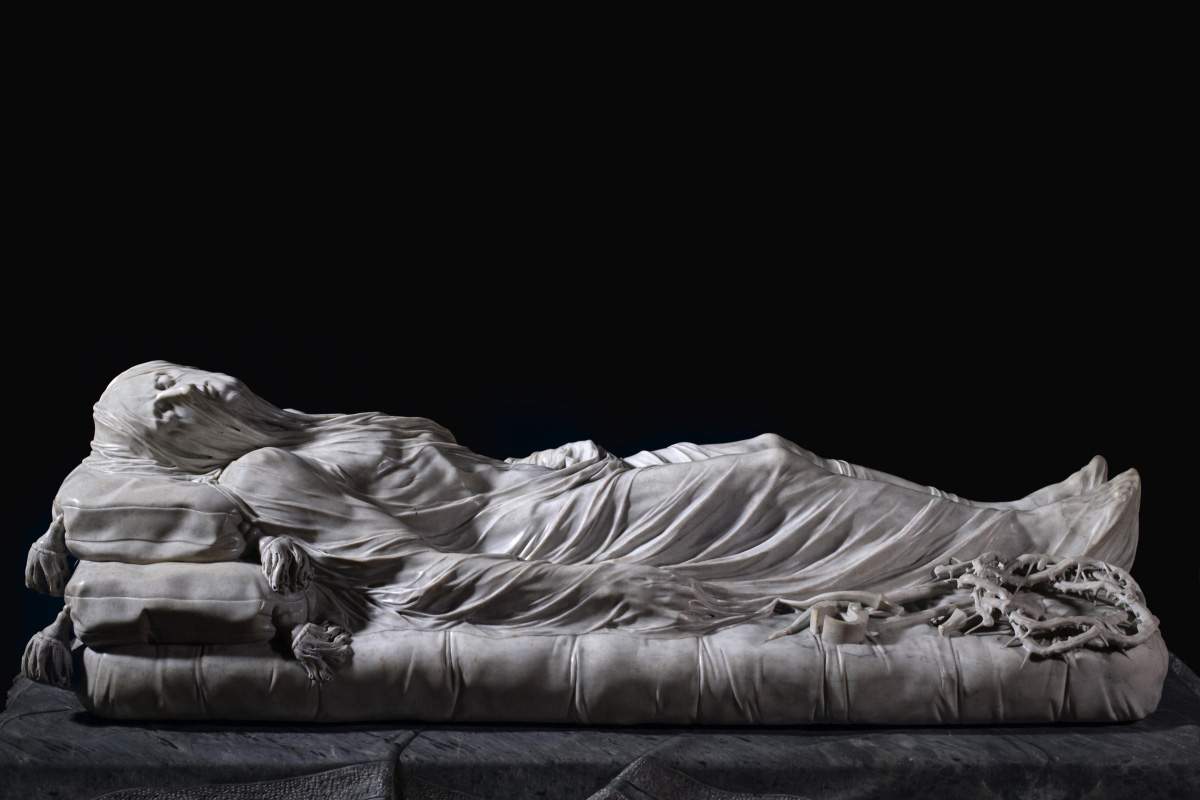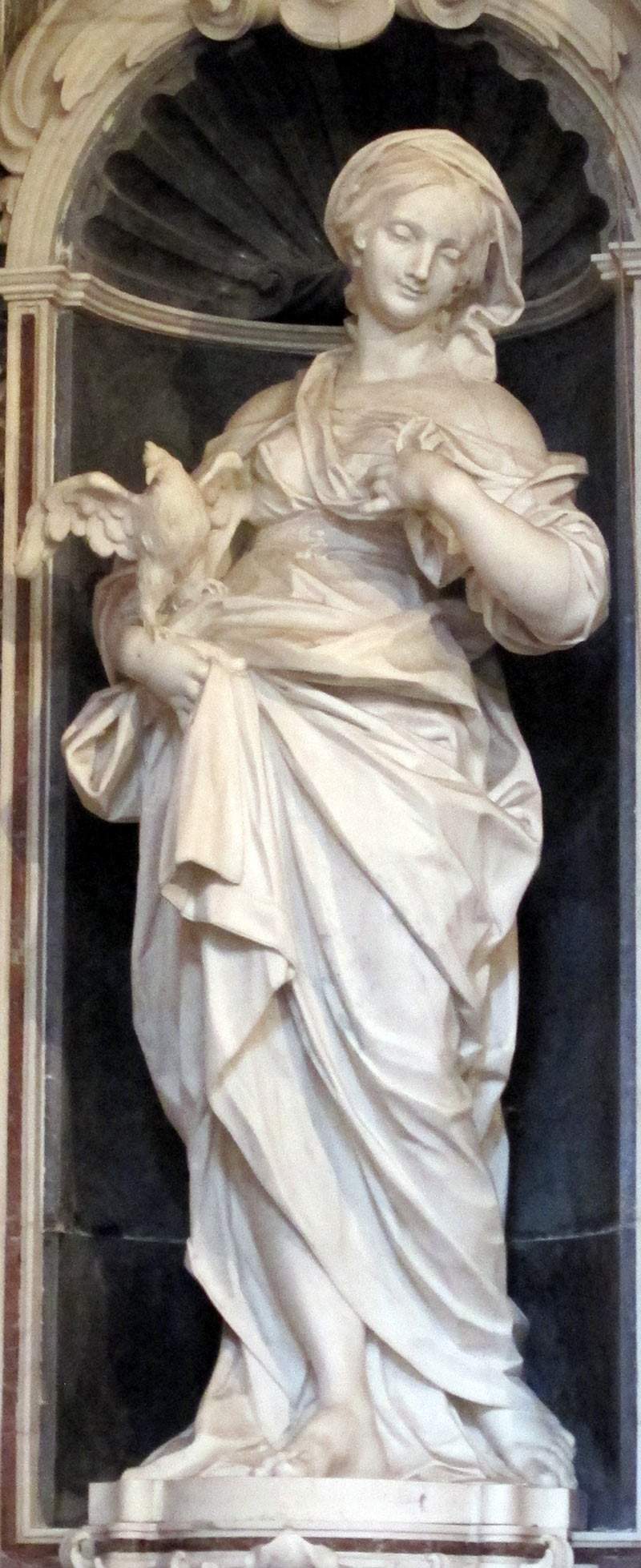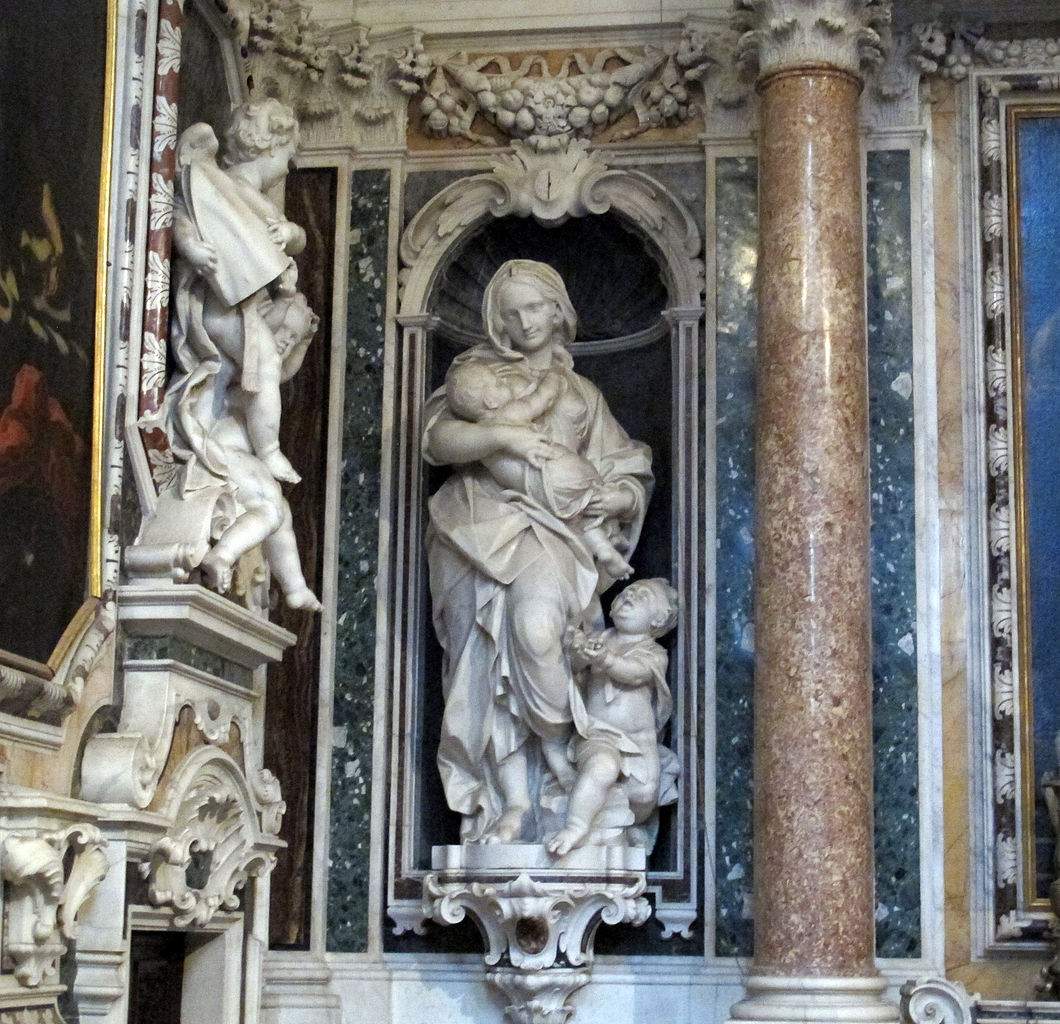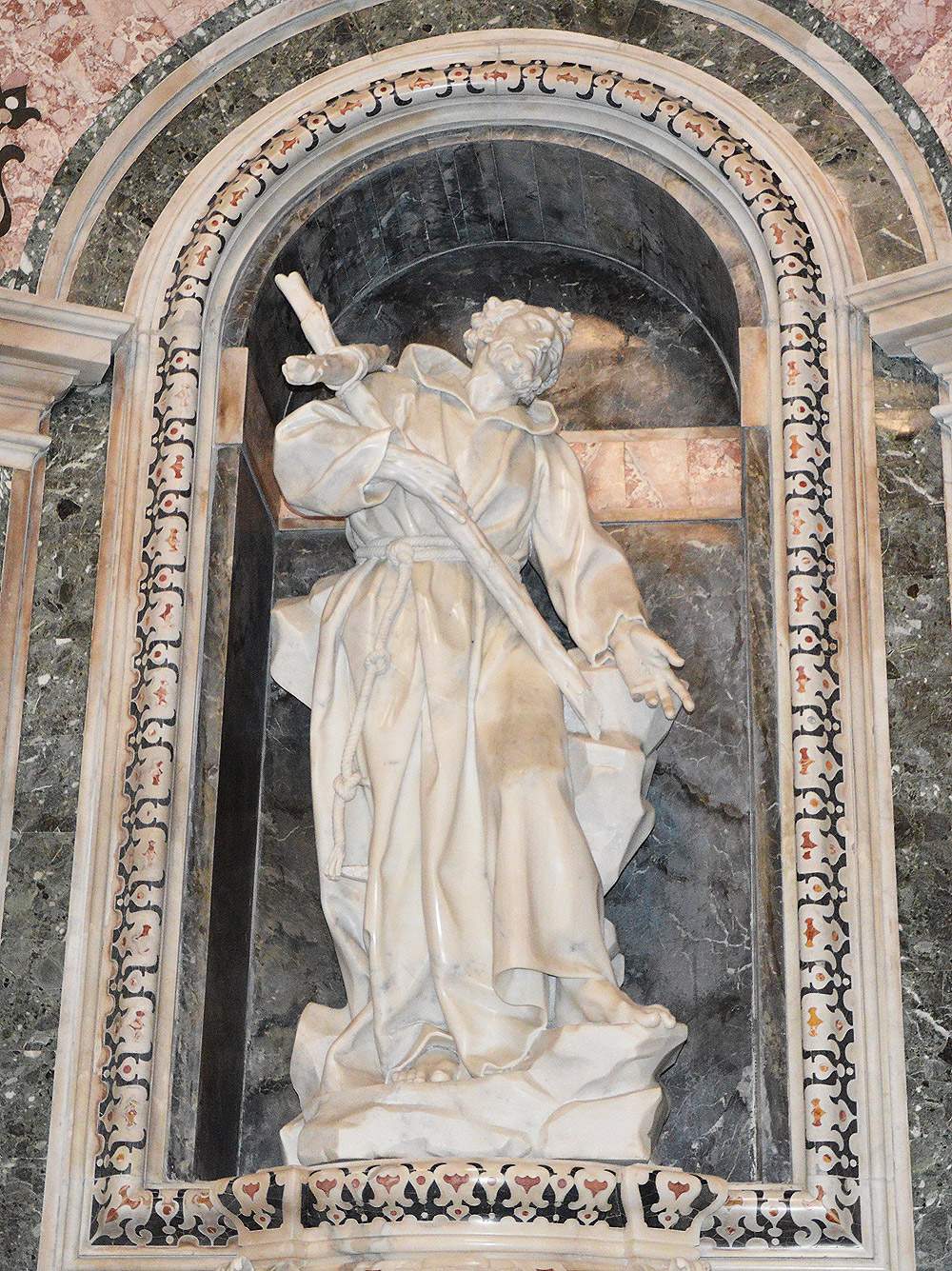Giuseppe Sammartino (Naples, 1720 - 1793) is considered one of the greatest virtuosos of 18th-century sculpture in Italy, best known for his sculpture of the Veiled Christ in the Sansevero Chapel in Naples, which has always been an object of interest because of the skill and mastery with which the artist was able to replicate the lightness of the veil through the use of marble. The statue has had a great deal of success over the years, to the point that it was visited several times by great artists such as Antonio Canova, and various legends began to spread around the real nature of the veil, which some thought was too thin to be really made of marble (many believed, in fact, that it was a real fabric crystallized according to esoteric processes).
A number of analyses and targeted research were carried out to confirm that indeed Sammartino had made the veil in marble and had worked it in a masterful manner, as had been requested by the client Raimondo di Sangro, prince of Sansevero. The success of the Veiled Christ secured the sculptor numerous commissions between Campania and Apulia in the second half of the 18th century. In addition, he was often called on sites of other works for his expertise and advice, thus establishing himself as an artist worthy of high esteem among his contemporaries.

There is little certain information concerning the biography of Giuseppe Sammartino, about whose personal life virtually nothing is known. On the other hand, we are left with a wealth of evidence of the numerous commissions the Neapolitan artist received throughout his career. His training probably took place in the workshop of the Campanian sculptor Matteo Bottiglieri, or the latter’s brother Felice Bottiglieri. The latter probably modeled some nativity statues, while he is definitely mentioned as a “chamber engineer” at the Real Camera della Sommaria, as his name appears in various architectural commissions. Matteo Bottiglieri’s name as Sammartino’s master recurs because of the similarities found between Bottiglieri’s Dead Christ (made in 1724) and Sammartino’s celebrated Veiled Christ sculpture (1753). Certainly, Sammartino studied a great deal of local Baroque sculpture, particularly Domenico Antonio Vaccaro, and came into contact with the Rococo style of Giacomo del Po.
There is insufficient information about the artist’s youthful works, as the earliest dated sculptures date from 1750, thus when the artist was already thirty years old. The most famous work of all, the Veiled Christ, is dated as early as 1753, so the artist must have been thirty-three years old (curiously, the same age as the subject depicted). After this important work, Sammartino in 1756 founded a company together with Francesco Pagano, so as to share some commissions involving some sculptural installations for churches in Naples. These included the Angels intended for the doorway to the high altar of the Church of the Gesù Nuovo, and a Trinity sculpted by the two for the Church of the Gesù Vecchio. The two worked together until 1758.
Often, the sculptor was approached to advise on works made by others, and it frequently happened that it was other artists who involved him. This happened with the Bologna sculptor Agostino Corsini, who contacted Sammartino for an appraisal on two marble statues depicting Fame that were to support the royal coat of arms at the entrance to a chapel in the royal palace at Portici. Such an award demonstrated that Sammartino was a sculptor not only highly renowned but also considered to be of high competence and worthy of esteem. Singular, too, was his relationship with architect Luigi Vanvitelli. He often issued calls for bids to find sculptors who could work on his projects, and several times he had received proposals from Sammartino, but had discarded them totally. After all, Vanvitelli was known to have a very difficult temperament and notoriously harshly panned the work of sculptors. However, Vanvitelli never openly criticized Sammartino as he was wont to do with others, showing that he held him in high esteem. Not only that, the architect wanted to appoint Sammartino as an expert on some works and introduced him as a member of theAcademy of Fine Arts.
In 1763 the sculptor wanted to move to an area of Naples close to his marble suppliers, specifically near Largo di Mercatello and the Fosse del Grano, and he expanded his workshop by training several pupils, the most famous of whom was the Neapolitan sculptor Salvatore di Franco. When Luigi Vanvitelli died in 1773, he was succeeded as royal architect by his son Carlo, who interrupted his father’s tendency to involve only foreign artists. From then on, Sammartino was inundated with requests from both Neapolitan noble families and the Bourbon court. Certainly the sculptor worked on the restoration of the Giant in 1778, in the royal palace, but in good probability he also worked on several stuccoes for the queen’s apartments, which, however, are not officially attributed to him.
In addition to his great success in Naples, the sculptor was also very present in Apulia. The Apulian commissions are explained as coming from personalities who already gravitated to Naples, and furthermore the Apulian provinces were the richest in the kingdom of Naples. Just as he was working in Apulia, specifically in San Severo, Sammartino fell ill and returned to Naples. He died a few months later, on December 12, 1793, and was buried at his explicit request in the church of the Concezione de’ Cappuccini, or Sant’Efremo Nuovo, which was located near his home.


The earliest works that can be attributed with certainty to Sammartino are dated 1750 and are in the cathedral of Monopoli (Bari); they are a statue depicting St. Joseph and one with St. Michael the Archangel. After this date, two works attributed to him are known to be found in the Church of Divine Love in Naples: two marble ovals with St. Joseph with Child and the Madonna and Child.
In 1753 Sammartino worked on his most important work. He inherited, in fact, the commission of the Veiled Christ from the sculptor Antonio Corradini, who had passed away and had only made time for a terracotta sketch. The sculpture was commissioned by Raimondo di Sangro, seventh prince of Sansevero, for the Sansevero Chapel(read more here). The patron was particularly keen that the commissioned sculptor fulfill certain precise requests. First and foremost, he asked that the sculpture be placed among a series of esoteric symbols, as he was a “grand master” of Freemasonry; he also wanted the body of the dead Christ to be reproduced life-size and covered by a shroud, rendered as if it were a transparent veil, which was to be made from the same block of marble used for the figure. Sammartino not only lived up to the request but also succeeded in bringing back into the marble block all the suffering of the dead Christ with uncommon skill. At a close look, one can see some signs of the martyrdom suffered on the face and body (moreover, the tools used for torture also turn out to be carved at the foot of the sculpture, namely the crown of thorns, nails and a tong). The body lies upside down on a mattress, under which the author’s signature is placed on the back of a pedestal. The most striking detail of the sculpture is undoubtedly the transparency and lightness of the marble veil, which because of its uniqueness has often been the subject of speculation. According to some legends, it was a calcified fabric, made by means of a procedure that Sammartino allegedly learned from his own client, a practitioner of alchemy. The said technique consisted of placing a treated veil on the statue, which would then be marbled through a chemical process. In fact, as fascinating as the thesis of the use of a real veil was, some analysis performed on the statue confirmed that it is for all intents and purposes processed marble. Moreover, there is written documentation consisting of payment receipts issued to Sammartino and letters written by Raimondo di Sangrio where the veil is explicitly mentioned as being made of marble.
The statue immediately had great resonance and fortune. It is said that Antonio Canova went several times to see it and declared that he wished he had made it himself. Apparently he had also tried several times to purchase it. Admiration for the work continues to this day, and celebrated tributes to it include the decision to use a photograph of the statue as the cover of a Requiem by conductor Riccardo Muti and, later, also as an image to relaunch the city of Naples as part of a communications campaign by the Campania region.
Sammartino, after the Veiled Christ, obtained numerous important commissions. In 1757 he was at work on the decorations of the church of the Carthusian monastery of San Martino on behalf of Giustino Nervini, making several putti and cherubs, also always inside the Carthusian monastery he signed the Virginity (which was initially supposed to be theLove of god) and the Prize in the chapel of the Assumption, while in the chapel of San Martino he made the Charity and the Fortitude (the latter replaced the Constance).Receipts for payment dated 1758 have also been found relating to a work for the Church of Saints Philip and James, namely the plaster figures of the two saints placed at the entrance. Also dating from 1760 are some decorations for the high altar of the Church of the Nunziatella, at first a Jesuit convent, then following their expulsion the church was annexed to the military school of the same name.
Also famous, almost on a par with the Veiled Christ, are the angels holding torches placed on either side of the balustrade of the Girolamini Church, dated 1787. The sculptor also had great fortune in Apulia, where, by the way, the largest and most complete known complex of statues by the artist can be found, specifically in the chapel of San Cataldo in Taranto cathedral dated 1773(read more here). Other Apulian works by Sammartino can be found at Monopoli Cathedral (1767), in Foggia (where he executed decorations similar to those in the Nunziatella church, also in 1767), in Martina Franca (1769) and in San Severo (1793). Finally, there are also works by Sammartino in Abruzzo, in the high altar of the cathedral of San Giustino (some are not sure of the attribution, however, which could also be relative to a follower) and in Cosenza. Recently, in 2021, a work by Giuseppe Sammartino hitherto known only from written sources was discovered at the Royal Palace of Caserta, namely the portrait of Charles Titus of Bourbon-Naples as an infant(read an in-depth study here).


The Neapolitan artist’s sculptures are practically all on site, exactly where they were placed in the first instance. So, it is possible to admire them all in Italy and more specifically in the regions of Campania and Puglia. There are also works preserved in museums, both Italian and international, but these are models or preparatory sketches.
With regard to the sculptures preserved in the original location in the city of Naples, the following are worth mentioning: the Veiled Christ (1753) in the Sansevero Chapel, the sculptural decorations for the Carthusian monastery of San Martino (1757) the decorations in the Church of the Nunziatella (1760), and the Angels holding the eyebrow (1787) in the Girolamini church. In Apulia, as noted earlier the most significant works by San Martino are found in Taranto Cathedral (1773), Monopoli Cathedral (1767), and also in Foggia, Martina Franca (1769) and San Severo (1793).
The museums that house sketches and models are: in Rome the Galleria di Palazzo Barberini, where there are sketches for Saints Peter and Paul for the facade of the Girolamini Church and the Museo di Palazzo Venezia, model of the Religion for the Cappella Regine in Forio d’Ischia and model of the Miracle of the Blind Man Born; in Vienna there is a sketch for the San Filippo Neri in Taranto Kunsthistorisches Museum; finally in New York, Metropolitan Museum there is a model for a statue of Saint Vincent Ferreri.
 |
| Giuseppe Sammartino, the sculptor of the Veiled Christ. Life, works, style |
Warning: the translation into English of the original Italian article was created using automatic tools. We undertake to review all articles, but we do not guarantee the total absence of inaccuracies in the translation due to the program. You can find the original by clicking on the ITA button. If you find any mistake,please contact us.